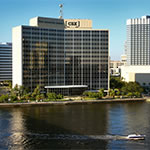As part of its ongoing commitment to sustainability, railroad transportation company CSX Corporation has obtained LEED certification for its 55-year-old corporate headquarters building located in Jacksonville, Florida.
“Rail is currently the most efficient way to move product on land, so sustainability is in our DNA,” says Carl Gerhardstein, assistant vice president of health, environment and sustainability, who says the company has been focused on sustainability for decades.
CSX’s sustainability strategy is based on three pillars. The first, environmental footprint, pursues a reduction of the company’s impact on air, water, waste, and land. The second, sustainable development, seeks to ensure the company is developing in the most environmentally responsible way possible. The third, engagement, seeks to connect with employees, the public, customers, and suppliers.
“It wasn’t a challenge to convince people to buy into the strategy because what’s good for the environment is also good for business,” Gerhardstein says. “The challenge was choosing which opportunity to take advantage of first.”

CSX is headquartered in Jacksonville, FL.
“We build LEED components into smaller facilities to make them LEED-equivalent, but we don’t necessarily go through the costly process of certifying every building, as we have 4,000 across our system,” Gerhardstein continues. “Our headquarters is one of our largest structures, and it made sense for the building to be LEED-certified.”
Constructed in 1959, the 485,000-square-foot building features more than 760 offices, 65 conference rooms and a state-of-the-art health and wellness center. Several years ago, the company began the process of pursuing its LEED certification for existing buildings and operations. “We like LEED because it’s not just about energy efficiency,” Gerhardstein says. “It gets into creating buildings that are good for occupants, which supports our core value that people make the difference.”
The process was an evolution of existing work. “We had been doing things that supported LEED for the entire 18 years I’ve been here,” says Peter Trolle, director of corporate services, “and our decision to pursue LEED certification didn’t cause us to change course.”
CSX worked with LEED consultant Mary Tappouni of Breaking Ground Contracting on the project. Notable sustainable elements include variable speed drives on air handlers, pumps, and chillers; a state-of-the-art environmental control system; lighting automated with occupancy sensors; high-efficiency plumbing fixtures such as touch-free, low-volume flush valves, and waterless urinals; a white roof that reflects sunlight and minimizes the heat island effect; and an efficient curtain wall.
Overall, the facility uses 30 percent less water than the baseline expectation for a similar building, and it has boosted energy efficiency by 27 percent. The company is also three years into a five-year plan to replace the entire electrical infrastructure in the 17-story office building. “Once complete, this new electrical infrastructure will give CSX the system to meet their demands for today and for their ever-changing and expanding needs for the future,” says James MacDonald, vice president of corporate services for Miller Electric Company, which is doing the work.
As part of the certification process, CSX also encouraged a change in behaviors. The headquarters has a recycling program, and the company encourages employees to use alternative forms of transportation. The company will pay for the public transportation of those who give up their parking spaces and offers reduced-cost parking to those who drive fuel-efficient vehicles.

